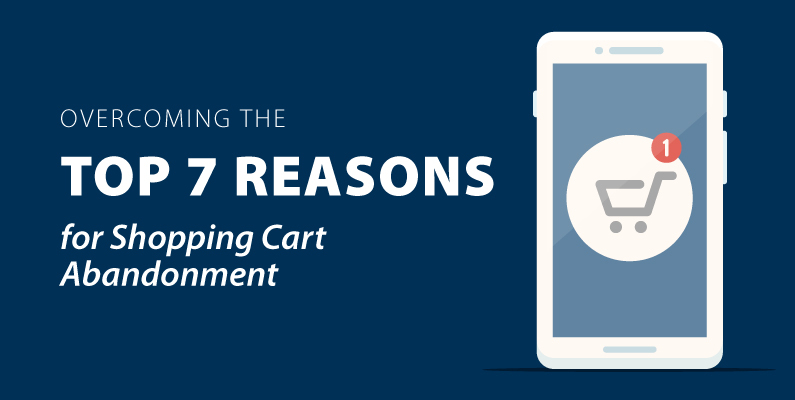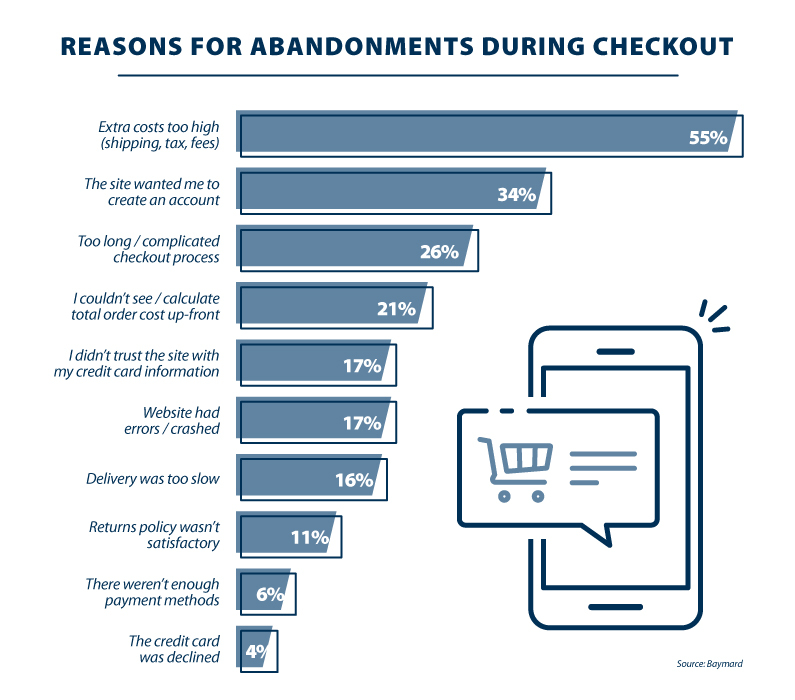Overcoming the Top 7 Reasons for Shopping Cart Abandonment
6 Min Read

If you own an e-commerce storefront or work for a company that sells products and services online, you’re probably familiar with a simple, frustrating fact: Shopping cart abandonment is common.
How frequent is it? For every ten shopping carts created, only about three will result in completed transactions. According to Baymard Institute, an independent web usability research institute, the average online shopping cart abandonment rate is 69.57%. That figure is based on 41 different studies.
Baymard Institute found an interesting reason for shopping cart abandonment when conducting its own study. Out of all U.S. online shoppers who abandoned a cart within the previous three months, the top reason, at 58% of respondents, was that they were just browsing or were otherwise not ready to purchase anything. The institute didn’t list it on their top reasons for abandonment, however. They considered it unresolvable.
The other reasons for shopping cart abandonment are easier to face head-on, and as a result, this article will concentrate on those factors. If you begin to consider the following reasons and implement strategies to overcome them, you’ll help your business or your employer drastically increase sales. You might just persuade even the most casual consumers who begin a shopping cart to complete their order.
7 Leading Reasons for Shopping Cart Abandonment
Here are the leading reasons for shopping cart abandonment and strategies on overcoming the factors. The list follows Baymard Institute’s study results, which gave respondents the option to choose more than one reason for abandoning their shopping carts. The reasons are in order from most frequently chosen reason to least, with the exception of “just browsing,” which was excluded.

1. Extra Costs Are Too High (shipping, taxes, fees) — 55%
It’s reasonable to imagine how consumers abandon shopping carts after seeing unexpected, pricey costs. Shipping, taxes, and fees can add to the total amount of an order well beyond the actual price of products.
A simple way to cater to customers is by providing all information upfront. If something like shipping incurs an extra charge, make that information easy to notice. Having a level of transparency early in the shopping process will help assure consumers they can trust the business or website. Also think about how, according to a report from the National Retail Federation (NRF), shoppers look at shipping costs before they even get to the checkout page. Sixty-five percent look up thresholds for free shipping before starting a cart.
Alternatively, consider free shipping. On orders less than $50, 75% of consumers in the NRF study expected delivery to be free, which is up from 68% in the previous year’s report. In a survey from e-commerce fulfillment services provider Dotcom Distribution, 91% of the 1,400 consumers questioned said that free shipping would make them more likely to become a repeat customer.
Look into adding to the price of items to provide customers with free shipping and related perks.
2. Required to Create an Account — 34%
Consumers who are required to create an account may shy away from completing the purchase. It takes time to create “yet another” account, and for some people, they don’t want their personal and sensitive information saved on another website.
It’s true there are benefits on both ends when checkout requires customers to create an account to complete a purchase. Customers benefit from not having to re-enter information in the future, and they get customized offers and recommendations. Businesses benefit from customized offers and recommendations too, along with other marketing opportunities. Plus, accounts make returns, exchanges, and refunds easier.
If the storefront has a strong base of repeat customers, you can consider requiring accounts — but appealing to customers’ desire to have a guest account is generally a good idea. It can especially help to reverse the trend of abandoned carts on mobile when checkout speed is at a premium. Mobile solutions provider Moovweb analyzed 1.8 million smartphone sessions and found that guest checkout increases mobile conversion rates. The share of revenue from mobile shoppers who chose guest checkout was 13% higher than users who were logged in.
3. Checkout Process Too Long/Complicated — 26%
This reason goes hand-in-hand with required account creation. Shoppers want to finish the checkout process as quickly as possible, and if it’s too long — due to having to create an account or otherwise — then they may leave.
An article from Baymard Institute noted that the average checkout flow had 14.88 field forms, which is twice as many as necessary. For most checkouts, websites can reduce form elements 20-60%.
4. Couldn’t See/Calculate Total Cost Upfront — 21%
Some shoppers go through the motions of creating their order because they want to see what the cost will be. To them, it’s a mystery; they don’t have the information they need from the outset.
So, provide the information upfront. If shipping is free and there are no hidden costs, integrate that onto the website’s front page and in marketing. Help customers understand what they’ll pay as quickly as possible to eliminate any questions they may have about an order’s cost.
5. Didn’t Trust Site with Credit Card Info — 17%
One of the most problematic reasons for shopping cart abandonment revolves around security concerns. It’s particularly concerning because it can undermine the root of an e-commerce business
There are many factors that can contribute to this lack of trust. If a site is outdated, has missing images, or other design flaws, it can put the whole website and business under question. Assessing how the website looks and feels compared to competitors can reveal any opportunities to improve on that front. A more direct reason may be missing SSL certificates, which indicates that the website is safe. Make sure that’s present and consider implementing a security seal on the site. Baymard Institute performed a survey and found that Norton, McAfee, TRUSTe, and BBB Accredited seals were the most trustworthy security seals.
6. Website Had Errors/Crashed — 17%
This reason complements the previous entry on the list. Any errors or lack of performance for e-commerce websites can cast doubt in consumers’ minds. That even extends to an issue like site speed. According to Google, 53% of mobile site visits exit a page that takes longer than three seconds to load.
7. Delivery Was Too Slow — 16%
If shipping is too slow — yes, even if it’s free — the sale may not happen.
In the NRF report, 39% of consumers said that they expected two-day shipping to be free, and 29% backed out of a purchase because two-day shipping wasn’t free. Unfortunately for some businesses, that may be the new standard. Amazon popularized “free” two-day shipping for paid Prime customers, making fast shipping an expectation for many shoppers. In May 2019, Walmart announced it would offer free two-day shipping, matching Amazon in, as Bloomberg dubbed it, the e-commerce “arms race.”
It’s clear that businesses need to stay current with online consumers’ expectations and best practices for e-commerce websites. Otherwise, abandoned carts and decreased sales can result. You can learn the skills to lead your business or help other companies navigate e-commerce with an online business degree or an online marketing degree. In a fully online format, you’ll gain the knowledge and skills needed to thrive in the business world.
Both of these programs from Concordia, St. Paul feature small class sizes with a personal learning environment geared toward your success. Learn from knowledgeable faculty who have industry experience. Get started with CSP today.